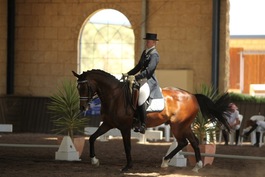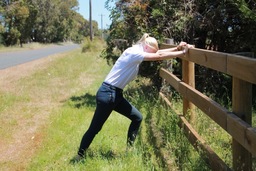
Riding involves using muscles outside of their natural alignment, and requires unique tensions that create stiffness in riders. I think the key for riders is to be proactive – keeping muscles in good condition rather than waiting until you have a problem.
Adductors, glutes, hamstrings and abdominal muscles all play a large role in stabilising the rider when in the saddle and, as such, need to be sufficiently developed and supple in order to work effectively. If these muscles are either under-developed or have a limited range of motion the rider will often rely on the muscles in their back (on either side of the spine), which is almost always very problematic and can even cause severe injury to the soft-tissue in the spine.
The back muscles are used in extension of the back (hollowing the back) and stabilising the torso. However, these long back muscles are not directly attached to the vertebrae in the back so they cannot effectively stabilise the spine. This is where the abdominal muscles come in to play. Over-active or tight back muscles can limit the ability of the ‘core’ or abdominal muscles to work in stabilising the spine – an important role if the rider is to sit quietly on the horse and not do lasting damage to their vertebrae.

Sports physiotherapist Anita Pope highlights “the abdominal muscles of the rider are of huge importance to stabilise and protect the spine, as well as aid in positional and postural balance for the rider in the saddle.”
Strength and conditioning specialist, Matt Jeffery from the British-based Rider Secrets, says the crouched position of the rider during the gallop and the load that translates down the thighs often contributes to tight thigh muscles and hip-flexors in riders. Contracting muscles repeatedly over time, or for long periods, can lead to shortening of the muscle fibres, which in turn can lead to altered joint mechanics and wear and tear in the joint. A lot of riders display rounded upper backs due to the forward arm position while holding the reins – often leading to a condition called Upper Crossed Syndrome, which can generate such problems as neck pain and shoulder impingement.
This sounds like a pretty damning description but it’s the reality we face when we spend time in the saddle – especially long hours. It highlights the importance of good posture in the saddle, and some before and after care for ourselves as an athlete.
It’s all very well to know all of this, now what are some easy, accessible and quick stretches we can build in to our pre- and post- ride routine?
Firstly – let’s have a think about what suppleness actually. We all talk about it in terms of our horses and some people will describe is as something to do with softness, some will dare to say it’s to do with submission (HELP! Have a flick through the Ethical Horse Training blogs to see why you can find me crying and rocking in the corner when people talk about submission in terms of their relationship with their horse!), while others will say it is being flexible.
Suppleness is your muscles ability to absorb movement. In other words, the ability for it to move passively through a range of motion. On the horse, that range is often small, but it is important to maintain its integrity through the full range of motion in order to keep the muscle fibres healthy and functional even through the smaller ranges required in the saddle.
Basic stretches and the use of a foam roller are effective ways to limit the damage to the muscles during the repetitive action of riding. Depending on the amount of time spent in the saddle ideally stretching of the glutes, hamstrings, quadriceps, adductors and calves should be carried out both pre- and post-ride and complimented with foam rolling daily. Upper body stretches are also of particular benefit to counter-act the amount of time spent establishing and maintain an upright posture in the saddle.
This all sounds a bit complicated but simple stretches and warm-up activities are easily built in to your normal routine. Try walking briskly, or even jogging, out to the paddock to collect your horse. You can use the hitching rail or mounting block as a stretching prop, and it’s amazing what else you can find in the tack room!
Hopefully there is some motivating information here – we’ll give you some ideas of specific stretches shortly.
SW



 RSS Feed
RSS Feed
